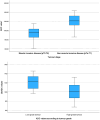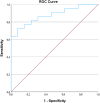A preoperative magnetic resonance imaging can aid in staging and treatment choice for upper tract urothelial carcinoma
- PMID: 38751955
- PMCID: PMC11090765
- DOI: 10.1002/bco2.337
A preoperative magnetic resonance imaging can aid in staging and treatment choice for upper tract urothelial carcinoma
Erratum in
-
Erratum.BJUI Compass. 2024 Dec 30;5(12):1324-1329. doi: 10.1002/bco2.482. eCollection 2024 Dec. BJUI Compass. 2024. PMID: 39744071 Free PMC article.
Abstract
Objectives: The aim was to investigate the predictive abilities of a preoperative diffusion-weighted MRI (dwMRI) among patients with surgically treated upper tract urothelial carcinoma (UTUC).
Materials and methods: Written consent was obtained from all participants in this prospective and ethically approved study. Thirty-five UTUC patients treated with radical surgery were examined with a preoperative dwMRI and prospectively included during 2017-2022. Two radiologists examined the CT scans and dwMRIs for radiological stage, and the apparent diffusion coefficient (ADC) in the tumours at the dwMRI was registered. The radiologists were blinded for patient history, final histopathology and the readings of the other radiologist. The radiological variables were analysed regarding their abilities to predict muscle-invasive disease (MID, T2-T4) and tumour grade at final pathology after radical surgery. The predictive abilities were assessed using chi-square tests, Student's t-test and calculating the area under the curve in a receiver operating characteristic (ROC) curve. Correlation between the two radiologists was quantified calculating the intra-class correlation coefficient. P-values <0.05 were considered statistically significant.
Results: Mean age was 72 years, 20 had high-grade tumour, and 13 patients had MID. The ADC values at the dwMRI were significantly lower among patients with MID compared to patients with non-muscle-invasive disease (930 vs 1189, p = <0.001). The area under the ROC curve (AUC) in an ROC curve to predict MID was 0.88 (CI 0.77-0.99, p = <0.001). The ADC values were significantly lower among patients with high-grade tumours compared to low-grade tumours (1005 vs 1210, p = 0.002). The correlation of the ADC measurements between the two radiologists was of 0.93 (CI 0.85-0.96, p < 0.001).
Conclusion: Tumour ADC at the MRI emerges as a potential biomarker for aggressive disease. The results are promising but should be validated in a larger, multicentre study.
Keywords: MRI; diagnosis; prospective study; staging; upper tract urothelial carcinoma.
© 2024 The Authors. BJUI Compass published by John Wiley & Sons Ltd on behalf of BJU International Company.
Conflict of interest statement
None.
Figures


References
-
- Birtle A, Johnson M, Chester J, Jones R, Dolling D, Bryan RT, et al. Adjuvant chemotherapy in upper tract urothelial carcinoma (the POUT trial): a phase 3, open‐label, randomised controlled trial. Lancet (London, England). 2020;395(10232):1268–1277. 10.1016/S0140-6736(20)30415-3 - DOI - PMC - PubMed
LinkOut - more resources
Full Text Sources
